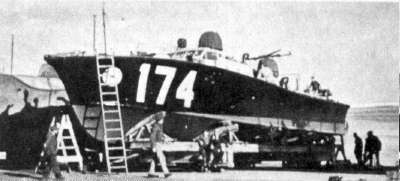
177 in the Channel in 1942 carrying twin Lewis Guns
and 20 mm Oerlikon. Just visible is the DF loop in front of the wheelhouse.
Known as the 'Whaleback' because of the distinctively curved sheer and 'humpbacked' cabin roof, this craft designed by George Selman F.R.I.N.A. stemmed from Hubert Scott-Paine's 70ft P.V MTB design of 1938.

177 in the Channel in 1942 carrying twin Lewis Guns
and 20 mm Oerlikon. Just visible is the DF loop in front of the wheelhouse.
All RAF HSLs were easily recognized by their paintwork except later in the war. when. serving in the Indian Ocean area they followed in principle the naval practice of using grey paint overall.

HSL 122 The first of the class in the Channel in 1940
carrying 'designed' armament of two single Vickers .303s
As mentioned above, these RAF craft were equipped with the minimum of defensive armament at first, but with increasing attacks from the enemy the standard two turrets containing single Vickers .303 m/gs was augumented in several ways. Sometimes twin 'stripped' Lewis guns were free mounted either side of the wheelhouse and the single turret mounted Vickers was replaced by twin .303 Brownings with in addition a 20mm Oerlikon cannon abaft the aft turret. Other craft carried .50 Brownings on each side of the wheelhouse and on each side of the rear turret whilst retaining the single Vickers in the turrets. HSL 174 carried the single Vickers in each turret but a twin .50 Browning mounting aft. I understand that the crews of some launches experimented with various captured weapons in true 'do it yourself' manner.

HSL 174 on the slip in Sicily in 1944
I pottered about on HSL 165 in 1947 whilst at the RAF Marine Craft Unit Port Fouad, Egypt This was reputed to be the last serviceable one of its type, though I suspect that there were others!
Hubert Scott-Paine was a pioneer in the use of resin bonded wooden structures before the last war, so as was to be expected the Whaleback had several parts of its structure manufactured from resin bonded wood. It was used in lateral and longitudinal frames, stems and keels and extensively in the wheelhouse and cabins. Scott-Paine also was noted for the close spacing of frames. These features coupled with the double diagonal skin of the hull meant that is craft became renowned for their great strength and ability to survive in seas which were considered to be far too rough for 'flimsy' hard-chine wooden craft! Many were the times when the Royal Navy was to reflect upon the ineptness of referring to the RAF Marine Branch as 'The Cardboard Navy' when, as the war went on, more and more reports came through from local Naval Officers In Charge, of HSLs rescuing aircrew in the most atrocious weather. It must be remembered that many commissioned Masters and also Coxswains of these craft were experienced ex-Merchant Navy men or men of long experience in the pre-war RAF Marine Branch hardened by years of attending to flying boats in all weather conditions.
The Whaleback was to the Marine Branch the equivalent of Fighter Command's Spitfire and is remembered by those who served on these craft with the greatest nostalgia. In many ways it was not the best design but it had a special appeal partly from its shape and partly because of its speed, but mainly. I feel because of the work it did during and after the Battle of Britain.

| Royal Air Force High Speed Launch (Type 2) 1940 |
| Length: 63 ft |
| Beam: 17ft |
| Extreme Draught: 3ft 4 inch |
| Engines: Power-Napier Sea Lion. Port and Starboard direct drive centre via Power patent V-drive. |
| BHP: 1500 (3 x 500) |
| Speed: 36.5 knots (designed) at 2450 rpm. |
| Range: 600 miles |
| Master: F/O Legge D.S.C |
| Coxwain: F/Sgt G Dewar |